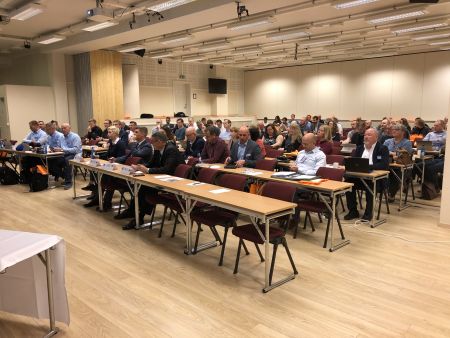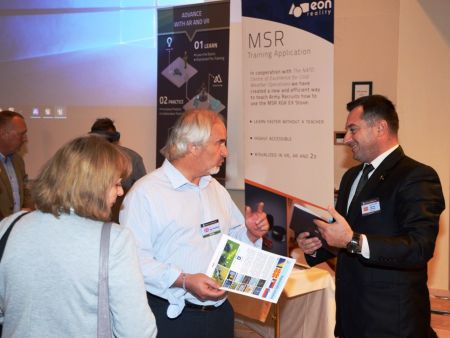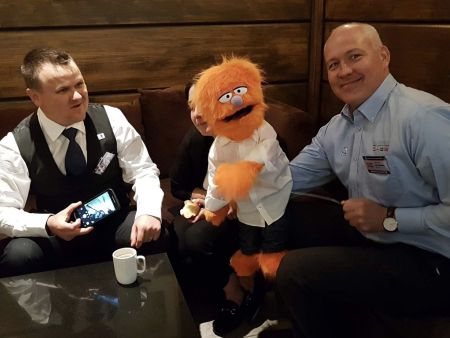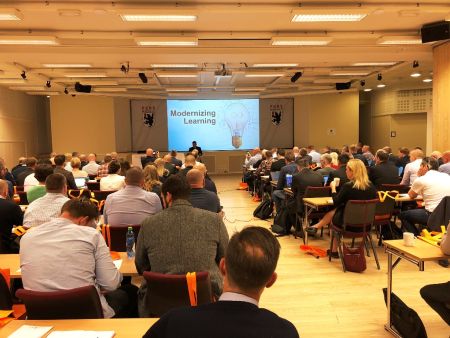WO II Bob Ludvigsen
Danish Defence College

Using 3d simulations and games for learning
There is an ever-increasing need for more efficient training and education. In this workshop, we will give you inspiration, and attempt to spark your thoughts on using 3d games and simulations for learning.
You will get a short introduction to two courses used in the Danish Forces, you will get your hands on both games and you will get to play:
- Basic familiarization on the EH-101 helicopter for technicians.
- Basic NCO training, how to select the perfect battle position for an infantry squad.
Both e-learning courses utilize 3d simulations, they are time saving and provide the onsite training a more effective outcome, furthermore one of the SIMS has xAPI implemented, in order to keep track of the students learning progress.
We will discuss the requirements the units had for these two SIMS. The recourses and time it takes to develop in-house are also addressed.
There will be a breakout where you will discuss usability, learning outcome and consider if and where you can use 3d games and simulation to support your learning needs.
We will finish off with a Q&A session.
Mr. Martin Boult
New Zealand Defence Force and ADL Partnership

Mr. Boult leads innovation and development of online learning solutions for NZDF. He has spent 25 years as a lecturer/teacher in tertiary and secondary education, specializing in 3D design and sustainable design.
His research interests include andragogy, gamification, mobile learning, learning technologies, and New Social Literacies for Learning. He is currently pursuing Post-graduate education (e-Learning) at Massey University.
Back to Reality: 3D Printing as an Extended Reality (XR) Component for Military Learners
This presentation considers the complete return of virtual technologies back into the hands of learners – literally.
Through the ongoing evolution of virtual technologies (VR/AR/MR) we have been long awaiting the world of haptics to catch up. The promise of simulated environments beyond the ocular or auditory realm have been the slowest to evolve and certainly the most expensive and cumbersome to deliver…and still we wait.
“Extended Reality essentially includes all the environments created for human and machine interactions that combine the real and virtual worlds. These are generally generated by computer technology and wearables. …... It is a superset which includes the entire spectrum from the complete real to the complete virtual. Its connotation lies in the extension of human experiences especially relating to the senses of existence and acquisition of cognition.”
Has part of the solution may have been staring at us for over 30 years?
3D printing or additive manufacturing (AM) arrived in the Cold-War era and now that patent protection has been removed this technology, like so many others has moved from the science and engineering labs of our Universities into K-12 classrooms and into our homes.
So what possible use does the military have for 3D printing?
Is it purely an effective means of prototyping and proof of concept for manufacturing or as a remote parts-replacement strategy to aid Logistics? In 2012 the US Military this strategy in Afghanistan and established mobile ‘Fab Labs’ (Fabrication Laboratory) to enable front-line soldiers to problem solve and prototype solutions to real problems in conflict zones.
Can 3D printing be effectively used as aid to learning with a focus on problem solving and improved cognition?
Where does 3D printing sit in the field of Advanced Distributed Learning?
Clearly it sits well within a Blended Learning approach but potentially adds value to the concepts of;
- collaboration to share knowledge
- technology to share, store, retrieve, and extend knowledge.
- distributed cognition
Is there a return on investment through the incorporation of this technology into our military schools and classrooms?
This session will include;
- Overview of the types of AM
- Underpinning learning theories – Social Constructivist and Constructionism.
- Examples of 3D printing in military classroom use for engineering technicians, serious games for warfighting strategy and information briefings for Humanitarian Aid/Disaster Relief (HADR).
- 3D examples of training artefacts will be provided.
- Pros and Cons, costs, personnel skills and knowledge requirements to set up a 3D lab to support military learning.
- Conclude with Q&A discussion.
MA Biljana Presnall
Jefferson Institute, United States
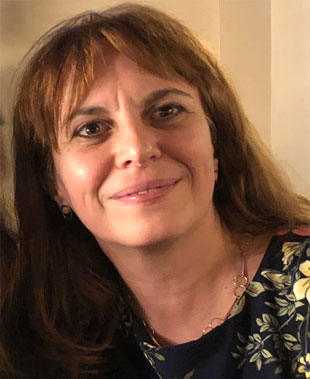
Choosing a Learning Record Store
In this presentation, we will overview the LRS options, and giveaway general guidelines for purchase or development of an LRS.
The key differentiator when utilizing Experience API (xAPI) is that organizations have to make a long-term decision on how to manage the collected data. This decision, similar to choosing a Learning Management System, is very often driven by many factors, including: cost per user, accessibility, flexibility, security, and ultimately sustainability of the solution.
The answers are directly connected with what you want to do with your data, as xAPI enables collection of activity data with high-resolution insights into specific learning activities.
The right choice of an LRS store should give you the ability to use this information in shaping your understanding of how engaging or valuable a learning experience is for a learner.
Mr. Gigi Roman
NATO School Oberammergau

In previous roles with NATO School and PfP community, he has overseen the development of web-based knowledge management systems and the re purposing of instructional materials for online delivery.
Gamification with ebadges - From paper sticker and certificates to digital credentials in blockchain
As NATO School Oberammergau (NSO) is continuously looking into implementing new tools and methods in training and education, student’s skills recognition, competencies and achievements through digital badges has been adopted for resident courses from NSO Academic Departments. In 2017 NATO School Oberammergau introduced digital badges to selected courses; however the idea to reward students’ accomplishments is not new. When NSO implemented the “Gender Sticker” earlier, in 2015, the first step towards a new way of recognizing students’ efforts was made. While the “Gender Sticker”, a special designed NSO sticker any student can earn who is successfully completing the ADL 169 (Gender Awareness) course online, was simply added to the classic NSO course certificates, the digital badges are an online recognition system. In addition to the traditional “Certificate of Completion”, the NSO offers a digital badge for selected courses to students who met all course requirements. Currently digital badges at NSO are used to help quantify the amount of formal time spent in training, or by participation in a program. However, digital badges have the potential to bridge both formal and informal learning in NATO. So far NATO School Oberammergau is currently the only NATO Education and Training Facility to provide their students digital badges. In this this paper the authors will demonstrate some initial findings following the implementation of the Digital Badging Project by NATO School Oberammergau and recommendations for other military organizations that may be looking to implement similar programs.
Dr. Jennifer Murphy
Quantum Improvements Consulting, United States

Improving marksmanship performance using interoperable performance data
Rifle marksmanship is a required combat skill, and the U.S. military is heavily invested in its training. However, the extent to which marksmanship skills are formally assessed is limited to qualification events. If performance were assessed throughout the training process rather than at just the end, instructors would have opportunities to forecast specific shooter problems, rapidly diagnose errors when they happen, and provide tailored feedback based on the root cause of an individual shooter’s issues. In this presentation, I will discuss research efforts aimed at improving the effectiveness and efficiency of U.S. Army and Marine Corps institutional marksmanship training using interoperable human performance data. To enable prediction of learning outcomes, a performance model was developed and validated using assessments of skills related to marksmanship performance. These measures included demographics, simulator performance, psychomotor skills, and data from a commercially available marksmanship training device. In addition, to support rapid diagnosis of shooter errors, measures of marksmanship fundamentals were developed and validated. Importantly, our research leverages the xAPI specification to enable training managers to track a trainee’s performance across technologies and instances of training. The findings from this research can inform how performance data can be used to forecast, diagnose, and remediate training issues.
Captain Henrik Wandall Lykke
Danish Army NCO School
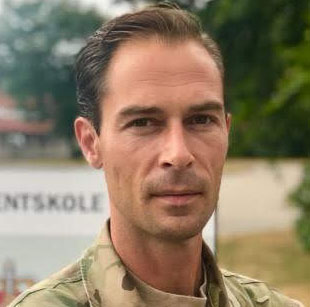
Video assisted learning – considerations, learning effects and possibilities.
This parallel session will cover why, how and what video assisted learning is adopted at the Danish Army NCO School. It will cover the background and motivation for implementing learning videos, the considerations the NCO School did before developing learning videos and the effect of implementing set videos. In the session we will also demonstrate some of the different videos and how they are used in training tactical leaders in order to connect knowledge and skills through another way of structuring lessons. Finally the session will invite all to participants in widening the perspective on the challenge of using e-learning objects in a training course dominated by learning skills.
Mr. Avron Barr
Institute for Defense Analyses, United States

Avron Barr started his career as a programmer at Stanford University; editor of the seminal Handbook of Artificial Intelligence; and founder of Teknowledge, an early AI startup in Silicon Valley. Since Teknowledge was sold in 1986, he has been an independent consultant, helping people understand, explain, and market cutting-edge software. Currently, he consults for the Institute for Defense Analyses and supports the US Advanced Distributed Learning Initiative’s Total Learning Architecture project. He volunteers as Chair of the IEEE Learning Technology Standards Committee and spends his free time hiking in the redwood forests around Santa Cruz, California.
Learning Technology Standards — The Next Wave
Technical standards often shape the economics of how new technologies are disseminated and applied. After Web- based instruction and computer-based simulation emerged in the late 1990’s, a wave of new standards that included the Sharable Content Object Reference Model (SCORM) defined product categories and allowed the possibility of multi-vendor training solutions. Without these first-generation learning technology standards, the costs and risks associated with acquiring and maintaining large-scale training systems might have dramatically slowed the technology’s adoption.
These standards still heavily influence how training technologies are developed and deployed today, but things are changing. While the first wave of standards focused on content portability across Learning Management Systems, we now must focus on “learner portability” across the web, across institutions, and across jurisdictions. A new set of standards is emerging – the last year alone saw the initiation of IEEE standards activities related to competencies and credentials; adaptive instructional systems; student data privacy and security; the Experience API (xAPI); and eBooks as platforms for learning. We will what the standards are, what problems they solve, and how they fit together. Implications for training organizations, product developers, systems integrators, and acquisitions commands are outlined.
Associate Professor Luke Dokter & Halvard Bjerke
Norwegian Defence University College (NDUC)

MS Teams & OneNote: Improving learning and collaboration.
The Norwegian Military Academy has undergone a massive reform and has fewer resources to deliver traditional classroom based learning. Digital transformation has been seen as one way to fill some of the gaps left in the classroom. This session will look at some of the current pedagogical theories and practices concerning digitalisation and how these a align with the Academy's chosen online and mobile learning platform (Office 365). Practical examples of how lectures at the Academy are utilising tools like OneNote and MS Teams to improve learning results and online collaboration. Tools like Office 365 create exciting new opportunities, but basic pedagogical theories must not be forgotten on the path to digitalisation.
Educational Technology Facilitator Krystal Weiss
Spring Branch ISD, United States

itslearing + GSuiteEDU a Partnership for Powerful Learning
In 2018, itslearning and Google announced a partnership that allows GSuite for EDU and itslearning to integrate their two platforms in a way that allows for a streamlined workflow for teachers and students. In this session you will learn more about the integration and a case study released by Spokes Education that quantifies the benefits of this integration. You will also learn how teachers and adminstrators are using this partnership to save time and increase instruction, and how students are using it to increase learning and collaborative time.
Warrant Officer 2 (OR8) Mark Stenderup Jensen
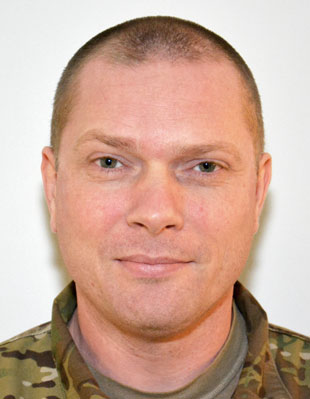
Danish Home Guard School, Denmark
16 years of experience as an instructor in the Danish army. 9 years of experience with ADL as a content creator. 3 years of experience with VR.
Virtual Reality on a budget
Defenses around the world are cut on budgets and the time for training is limited. More of the technical training is now done as on-the-job training.
The aim of this workshop is to inspire the participant to do technical training in a new way using Virtual Reality (VR). VR usually cost a lot of money but this workshop will introduce the participant to create and use "budget friendly" VR.
At the workshop we will be talking about technology, free and paid software and discuss if this is relevant in the military.
Seats for the actual workshop are limited.
OR-7/Senior Instructor Jan Zielinski


Aircraft Systems Technical Instructor at Air Force Technical Training Centre Kjevik. 3D modeller, animation and additive production (3D print etc.) specialist with knowledge gained through.
A Practical Approach to the Use of 3D Printing in a Learning Environment.
This workshop will demonstrate a very practical approach to how 3D printing can be utilized in learning. The production scalability with today's additive manufacturing technology has made it possible to produce learning aids that can be used to enhance learning. 3D printed training aids opens up for hands-on training that can be scaled for pedagogical efficiency, transportability and cost effectiveness.
Keynote speakers: 45 mins.
Speakers (Auditorium): 30 mins.
Parallel sessions: 40 mins.
Workshops: 2x40 mins. or
Workshop: 90 mins.
INCLUDING QUESTIONS!
Exhibition in every break








